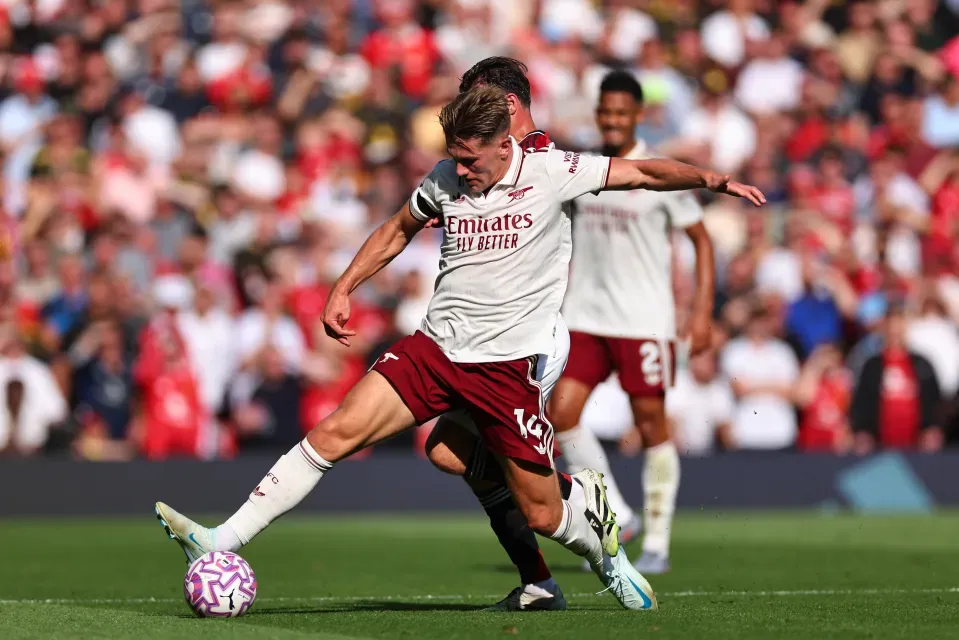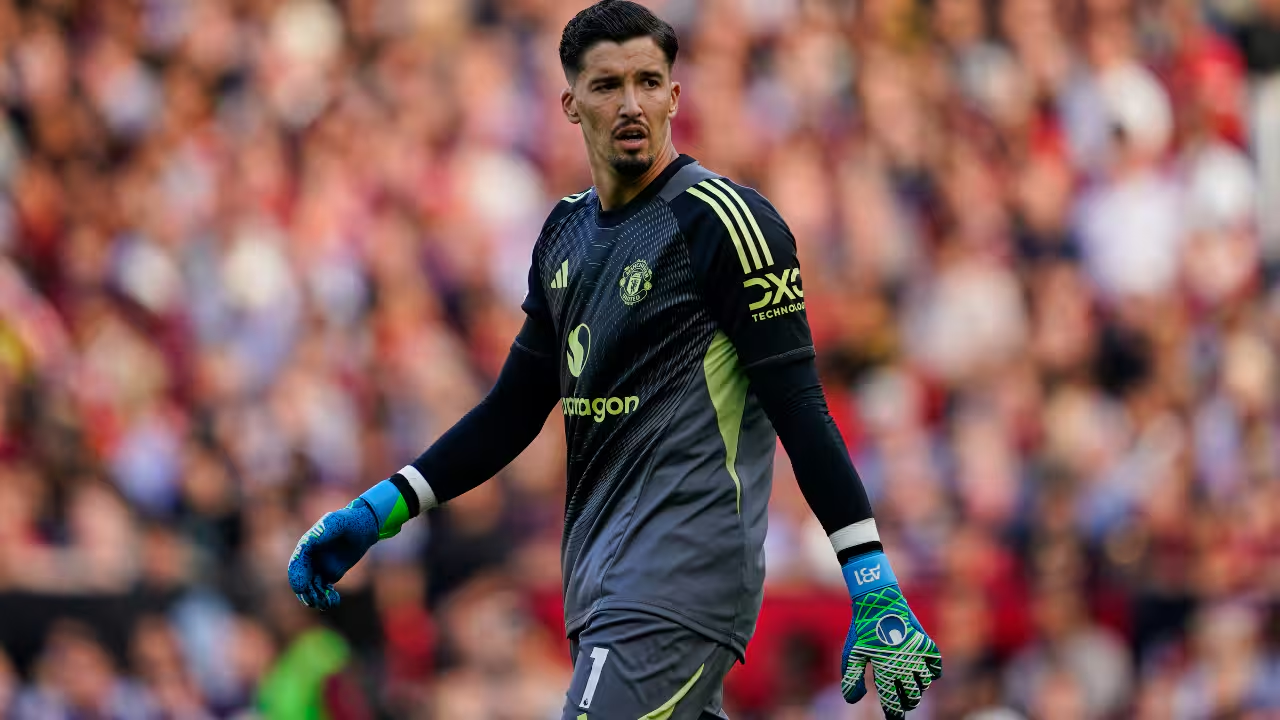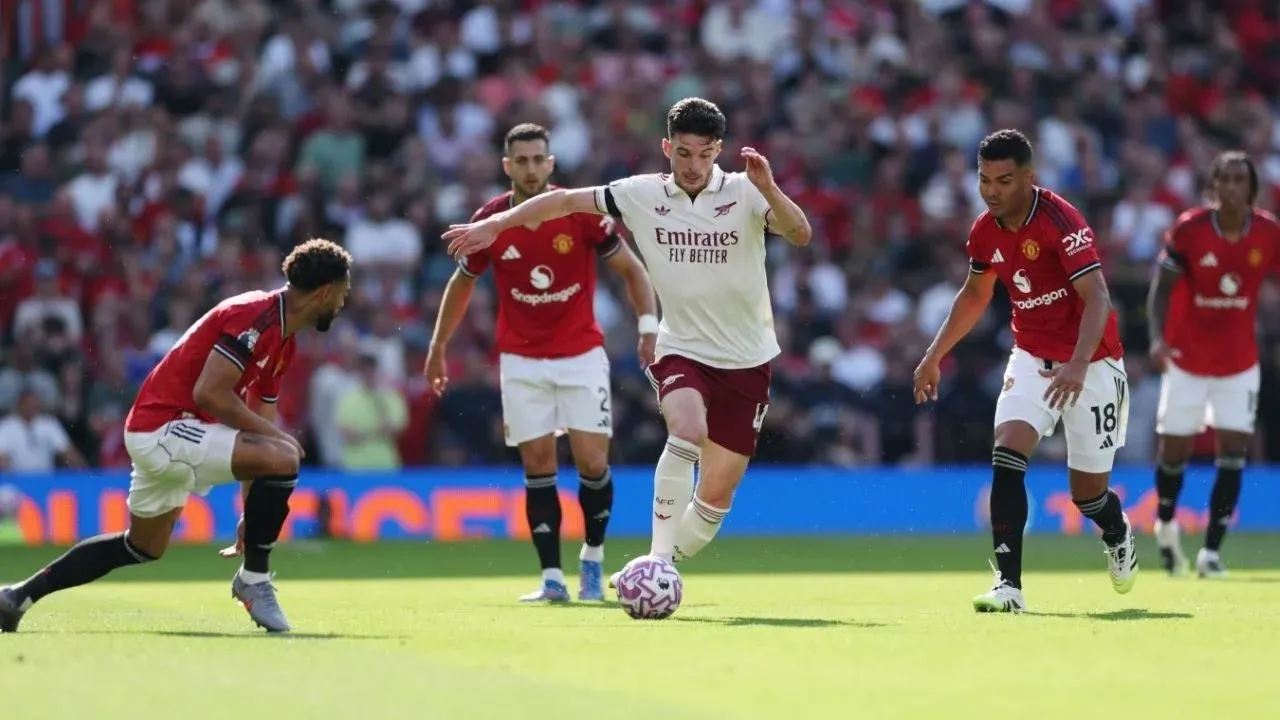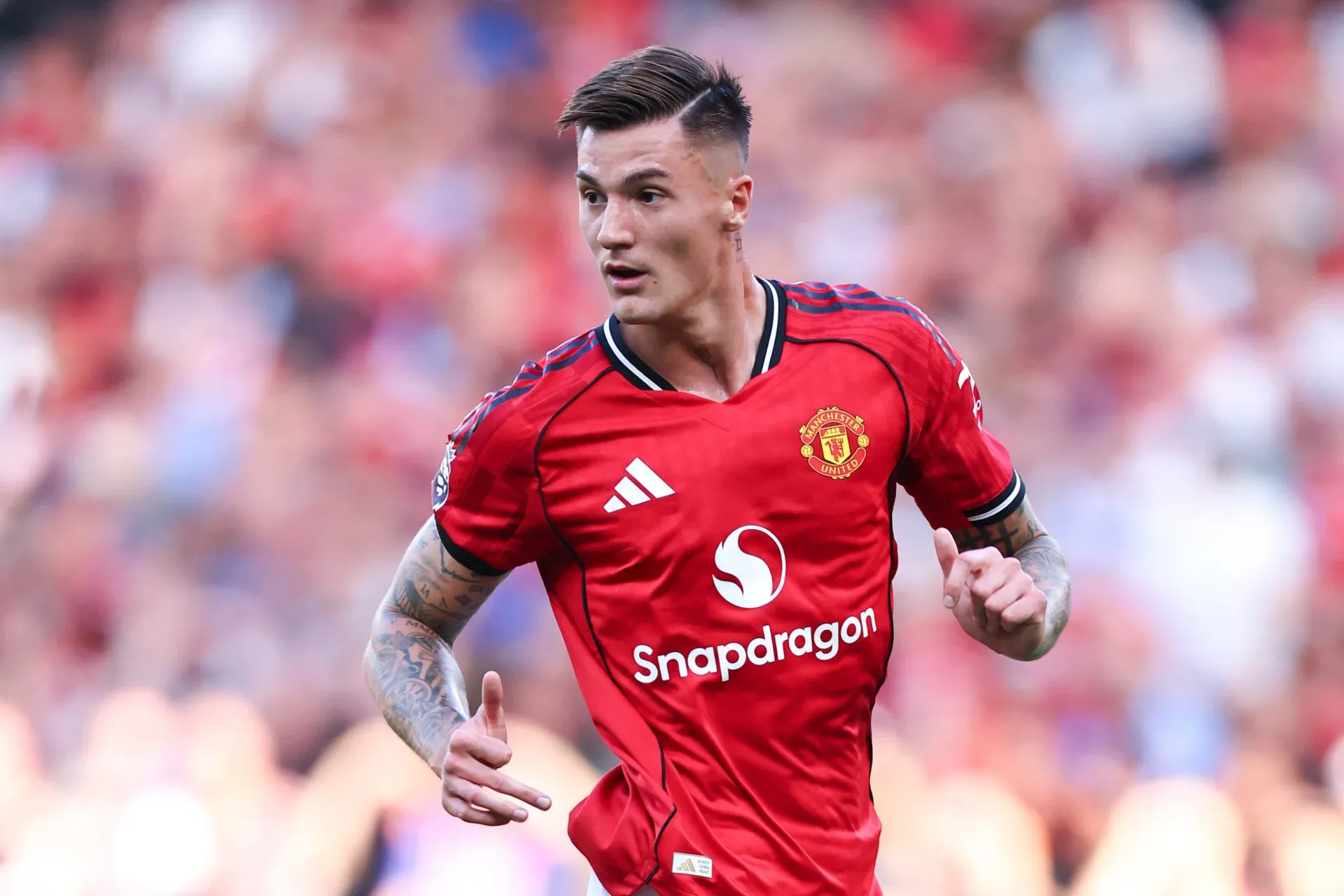Arsenal 1-0 Manchester United: Match Review

Arsenal kicked off their campaign to clinch the Premier League title with a 1-0 victory against Manchester United at Old Trafford, courtesy of a novel set-piece strategy.
Avram Glazer, co-owner of Manchester United, was present at the stadium, witnessing a squad missing the recently recovered goalkeeper Andre Onana and forward Rasmus Hojlund, who, according to The Athletic, faces a battle to secure playing time under manager Ruben Amorim. Arsenal’s 15-year-old prodigy Max Dowman traveled with the squad but did not feature in the matchday lineup.
Amorim opted for Altay Bayindir in goal, but the keeper could not prevent Riccardo Calafiori from nodding in a corner delivered by Declan Rice in the 13th minute. United responded spiritedly, with Patrick Dorgu striking the post, and Arsenal’s David Raya producing a stunning low save to thwart Matheus Cunha.
Arsenal’s new signing, Viktor Gyokeres, acquired for an initial £55m ($75m) from Sporting CP, played for an hour but found it tough to leave his mark. Meanwhile, Manchester United’s Benjamin Sesko, their recent acquisition from RB Leipzig as part of a £200m attacking overhaul, came off the bench for the final 25 minutes.
Raya parried a header from Bryan Mbeumo, and Sesko narrowly missed with a header as United pressed for a leveling goal. However, Arsenal stood resolute, extending their unbeaten streak in Premier League away matches to 15 games.
The Athletic’s Carl Anka, Art de Roche, and Ahmed Walid dissect the pivotal moments of the encounter.
How does Arsenal’s innovative free-kick strategy function?

While a new season dawns, Arsenal’s creativity from set pieces remains undiminished.
Since the arrival of set-piece specialist Nicolas Jover from Manchester City in the 2021-22 season, no team has outscored Arsenal’s 71 goals from set pieces (excluding penalties) in the Premier League. Liverpool (64) and Manchester City (60) trail behind.
The routine, involving five players positioned at the edge of the penalty area before the corner, isn’t entirely novel. Arsenal tested it during their third pre-season friendly against Tottenham Hotspur and reaped rewards from their first corner of the competitive season.
Two players from the group of five—Gabriel Martinelli and Martin Zubimendi—created disruption in the central area as the ball was delivered. Mason Mount failed to mark William Saliba effectively, positioning himself poorly alongside Bayindir, which allowed Calafiori to exploit space at the back post.
Arsenal had previously scored from a back-post corner in pre-season against Villarreal, albeit via a different routine involving Christian Norgaard. Regardless, creating space at the far post often proves more threatening than central congestion.
Given Arsenal’s goal-scoring record against Manchester United from set pieces last season, their early lead was hardly surprising.
How did Gyokeres fare on his Premier League debut?

Viktor Gyokeres played just shy of an hour in his first Premier League outing, echoing his initial pre-season appearance for Arsenal against Villarreal.
The 27-year-old displayed eagerness to influence the game but faltered in crucial moments. Matthijs de Ligt initially dominated their personal duel, though the Swede gradually found his footing, providing Arsenal with an outlet during critical phases.
Similar to his pre-season displays, Gyokeres’ runs behind the defense were unselfish, often seeking out Martinelli or Bukayo Saka. However, misplaced passes and missed opportunities hindered his impact.
This lack of precision wasn’t exclusive to Gyokeres but reflected Arsenal’s broader performance. From the outset, Mikel Arteta’s side struggled to match United’s tempo, adopting a reactive rather than proactive approach, despite flashes of attacking promise.
Arsenal owed much to Raya, whose saves in both halves secured a narrow victory and a clean sheet.
Kai Havertz, filling in for Gyokeres, was unremarkable despite winning several fouls. As Arsenal prepare to face Leeds United at the Emirates, Gyokeres’ starting position appears secure.
Do Manchester United face a goalkeeping crisis?

Amorim revealed pre-match that Onana had recovered from a hamstring injury but opted for Bayindir in goal.
The 27-year-old Bayindir has endured an unusual two seasons at United. Unlike many clubs that deploy their second-choice goalkeeper in cup competitions, Bayindir serves as a traditional backup, stepping in primarily when Onana is sidelined or rested, as seen in pre-season.
His limited passing ability and vulnerability at corners have been notable weaknesses. Last season, he conceded an Olympic goal, and opponents frequently crowd the six-yard box to restrict his movement during set pieces.
Arsenal’s opening goal showcased a clever setup but also exposed Bayindir’s struggle to overpower Saliba and command the ball.
“He needs to be more dominant,” remarked former Manchester United defender Gary Neville on Sky Sports. “He might claim he was impeded, but with all the pushing and pulling, he has to assert himself.”
Former England goalkeeper Joe Hart suggested Bayindir should have used his left arm to fend off Saliba while punching with his right. To thrive as a Premier League No. 1, a goalkeeper must combine shot-stopping with physicality, an area where Bayindir’s hesitancy—coupled with United’s set-piece frailties—creates a vulnerability.
Switching to Onana, who has trained only thrice since returning to fitness, may not resolve the issue. The Cameroonian has also struggled against teams crowding the six-yard box, and his shot-stopping can be inconsistent.
Should United prioritize a new goalkeeper before the transfer window closes? The Athletic reports that no new signing is likely unless either Bayindir or Onana departs. Fans may clamor for Gianluigi Donnarumma, but his struggles with corners and high balls persist despite his 6ft 5in stature. Emiliano Martínez excels in this area, but Aston Villa would likely demand over £40m ($54.2m).
United’s lack of assurance around their penalty area remains a concern, and Amorim may need bold solutions to address it.
What improvements did Manchester United show?

Since Amorim’s appointment in November 2024, Manchester United have struggled to embody the physicality required for his preferred 3-4-3 formation and tactical principles.
Amorim himself noted in press conferences that United’s stronger Europa League performances stemmed from the lower physical demands compared to the Premier League.
In their 2025-26 Premier League opener against Arsenal, United displayed marked improvement off the ball. Their pressing was sharper, with no hesitation in marking Arsenal players tightly, and they won more midfield duels.
This heightened intensity not only bolstered their defensive work but also generated transitional attacking opportunities. United repeatedly regained possession and swiftly transitioned, either switching play to Mbeumo on the right or driving forward, as seen when Dorgu hit the post in the 30th minute from a rapid counter.
In our Arsenal 1-0 Manchester United: Match Review, we analyzed the key moments of the clash and their impact on the season ahead. If you want to turn such insights into a practical advantage, make sure to check out the football betting section on 1xBit, where you’ll find strategies, tips, and useful tools for more successful predictions.
How did Sesko perform off the bench?

Around the 20-minute mark, Mbeumo’s pass found Diogo Dalot on an overlapping run in the final third—a move characteristic of Amorim’s style: a direct ball into the channels, won by the No. 10, with a spare attacker exploiting space against a disorganized defense.
However, Dalot’s run—aside from being flagged offside—lacked support in the penalty area. United’s front three of Mbeumo, Cunha, and Mount offered energy and fluid rotations but lacked a consistent presence in the box. By the 60th minute, United had four shots on target compared to Arsenal’s three, though most came from less threatening wide angles, with Cunha’s low effort the closest.
Amorim introduced Sesko in the 65th minute, replacing Mount at the spearhead of the attack. The 22-year-old immediately sought spaces between Gabriel and Calafiori, aiming to capitalize on quick passes in behind.
Before the second-half water break, Sesko’s clever run dragged both Arsenal center-backs away from Mbeumo at the back post, though Mbeumo and Amad couldn’t convert. Five minutes later, Sesko darted toward the penalty spot to meet a Dorgu cross, which sailed over to Mbeumo, whose header was saved.
Sesko’s explosive pace over short distances promises to trouble Premier League defenses, and his willingness to press from the front will endear him to Amorim and fans. While his first touch and aerial timing need refinement, his movement and physicality set him apart from Hojlund and Joshua Zirkzee.
Sesko provided United with a combative focal point absent in many matches last season. His goal tally will ultimately define his impact, but his 30-minute cameo offered encouraging signs.
FAQ
Arsenal’s innovative set-piece routine, involving five players at the penalty area’s edge, created chaos, allowing Riccardo Calafiori to score the decisive goal from a Declan Rice corner in the 13th minute, highlighting their set-piece prowess.
Altay Bayindir’s struggles with physicality and set-piece defending, coupled with Andre Onana’s inconsistent shot-stopping and similar vulnerabilities, expose United’s goalkeeping weaknesses, raising questions about potential new signings.
Gyokeres struggled to make an impact in his Premier League debut, lacking precision, while Sesko’s energetic substitute appearance showed promise with dynamic runs and pressing, though his first touch needs refinement.

Sergey Ilyin
An experienced specialist in the field of betting and gambling. He analyzes market trends, player behavior, and the dynamics of online gaming platform development. An expert in the intricacies of sports betting and knowledgeable about the regulatory framework of the gambling industry.
